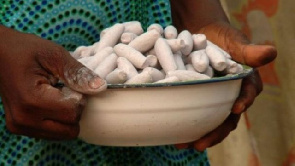White clay poses cancer risk – Researchers

Edible white clay, known locally as ‘hyire’ poses potential cancer risk.
That is one of the outcomes of a study by scientists at the Kwame Nkrumah University of Science and Technology (KNUST), Kumasi-Ghana.
The researchers found levels of heavy metals such as lead, over three times the required daily intake for a normal adult.
The consumption of clay, especially among pregnant women and children, has been reported in several countries across continents particularly in Africa.
Studies shave reported on countries such as Cameroun, Congo and Nigeria (in Africa), parts of India, China and the Philippines ( in Asia) as well as the Americas.
Many reasons, including nutritional, religious and cultural, have been linked to the habit.
A 2013 study indicates 28 percent of women of reproductive age in Ghana eat averagely 70 grammes of clay daily.
White clay benefits are said to include the ability to absorb dietary and bacterial toxins associated with digestive tract disturbance.
However, in 2014 researchers in Johannesburg, South Africa found pregnant women who eat clay to be at risk of anaemia and other health conditions.
For the study at KNUST, 30 pieces of baked, ready -to -eat white clay (hyire) samples were randomly obtained from 10 markets in the Kumasi metropolis.
The clay was found to contain essential nutrients such as potassium, iron, calcium and zinc.
Toxic metals like lead and arsenic were also detected in the current study.
The World Health Organization (WHO)- permitted maximum tolerable daily intake which is estimated on the assumption that an adult who weighs 60 kg consumes 70 g of white clay a day, indicated that the levels of lead and arsenic substances in the samples are far above the tolerable values set by the WHO.
“The consumption of these clays by adults and children over a long time poses a potential health threat due to the likelihood of accumulating for a long period.
“These high levels of toxic metals (lead and arsenic) render the clay unwholesome for human consumption,” observed Dr. Marian Asantewah Nkansah, the lead scientist on the study at KNUST.
Source: Myjoyonline.com





